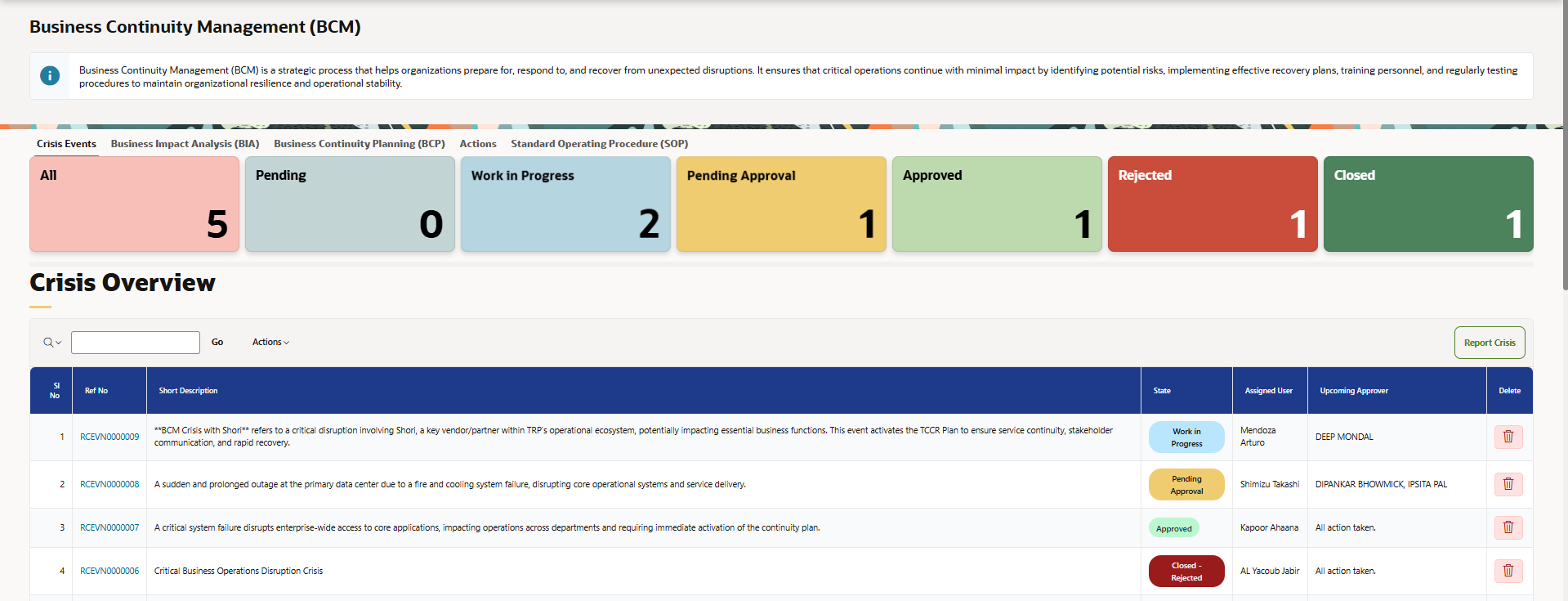

.png)
.png)
Preparedness & Response
Helps organizations get ready for and effectively respond to unexpected disruptions.


.png)
.png)
Helps organizations get ready for and effectively respond to unexpected disruptions.
Ensures critical operations continue with minimal impact during crises.

.png)

.png)

Implements effective recovery strategies and trains personnel for rapid restoration.

.png)
Regularly tests procedures to strengthen organizational resilience and operational stability.
Business Continuity Management (BCM) is the process of developing and implementing strategies that ensure an organization's critical functions can continue or be rapidly restored during and after a disruption. It aims to minimize the impact of crises, safeguard assets, and maintain essential operations.
✔ Comprehensive Business Impact Analysis: BCM tools perform in-depth analyses to identify critical business functions and evaluate the potential consequences of disruptions. This helps in prioritizing recovery efforts and resources effectively.
✔ Automated Recovery Planning: The system provides a framework for creating, automating, and managing detailed recovery plans. These plans ensure that all departments are aligned and ready to act swiftly in the event of a disruption, maintaining business continuity.
✔ Real-time Threat Monitoring and Alerts: BCM solutions include real-time monitoring of potential threats, such as natural disasters, cyberattacks, or operational failures. Automated alerts are sent to relevant stakeholders to initiate immediate response actions.
✔ Crisis Management Coordination: Facilitates coordination among teams during a crisis by providing communication tools and a centralized platform for tracking the status of recovery activities and resource allocation.
✔ Testing and Simulation: Allows organizations to conduct regular tests and simulations of their business continuity plans. This ensures that strategies are effective, up-to-date, and that staff are well-prepared to execute them in a real crisis.
✔ Compliance and Reporting: Ensures that the organization’s continuity plans meet regulatory requirements and industry standards. The system also generates reports that document compliance and track the effectiveness of continuity strategies.
✔ Resource Management: Helps manage and allocate necessary resources, such as personnel, technology, and physical assets, to ensure that critical operations can be maintained or quickly restored.
These features collectively ensure that an organization is well-prepared to handle disruptions, minimize downtime, and maintain the trust of customers, partners, and stakeholders during crises.
✔ Reduced Downtime: BCM minimizes operational disruptions, ensuring rapid recovery of critical functions to sustain business continuity.
✔ Increased Resilience: It enhances an organization’s ability to withstand and quickly recover from unexpected crises.
✔ Asset and Reputation Protection: BCM safeguards financial assets and maintains customer and stakeholder trust by ensuring continued operations.
✔ Regulatory Compliance: It helps organizations meet legal and industry requirements, mitigating risks and avoiding penalties.
✔ Effective Crisis Management: Effective Crisis Management: BCM improves coordination and communication during crises, enabling a swift and organized response.
ERM is a strategic approach to identifying, assessing, and managing risks across an organization, enhancing decision-making and operational resilience. It helps in proactively addressing risks to ensure business continuity and achieve organizational goals.
iRMCloud's easy-to-use dashboards provide a centralized, intuitive view of all risk-related data, making it simpler for managers to monitor, analyse, and respond to risks in real-time, thereby improving the efficiency and effectiveness of the organization's risk management process.
iRMCloud enhances ERM by offering user-friendly dashboards for a clear overview of risks, latest risk insights out-of-the-box for immediate risk identification, an inbuilt risk matrix for simplified risk evaluation, and regular updates to stay aligned with evolving risk landscapes.
The inbuilt risk matrix in iRMCloud simplifies the complexity of risk assessment by categorizing risks based on their severity and likelihood, aiding in prioritizing risks and formulating strategic responses, thus making the decision-making process more streamlined and data-driven.